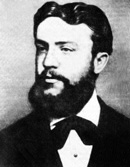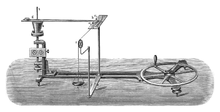Johann Puluj
Johann Puluj ( Ukrainian Іван Павлович Пулюй Iwan Pawlowytsch Puljuj , scientific transliteration Ivan Pavlovyč Puljuj ; born February 2, 1845 in Grzymałów , Galicia , Austria-Hungary ; † January 31, 1918 in Prague , Bohemia , Austria-Hungary) was an Austrian Hungarian physicist and electrical engineer of Ukrainian nationality . With the development of his Puluj lamp, he laid an important foundation for Röntgen's discovery of X-rays . Puluj was one of the first physicists to use X-rays for medical diagnostics .
Life
Johann Puluj was born into a religious Greek Catholic family in the Ternopil area . His parents Pawlo Puluj and Ksenija (née Burschtynska) were wealthy landowners. From 1857 to 1865 he completed school education at the humanistic grammar school in Ternopil in Galicia , at that time a crown land of the Austro-Hungarian monarchy . At the grammar school, all subjects were taught in German. From 1865 to 1869 Puluj studied at the Theological Faculty of the University of Vienna and then from 1869 to 1872 Mathematics , Physics and Astronomy at the Philosophical Faculty. He was supported by a Franz Josef Scholarship and was a private tutor for families in Vienna during his studies .
From 1872 to 1874 Puluj was an assistant in Viktor von Lang's laboratory and was engaged in researching the interdependence of internal temperature and air friction. After that he was a teacher of mathematics, mechanics and physics at the Imperial and Royal Naval College Fiume (now Rijeka in Croatia ) until 1875 . There he developed a new type of device for measuring the mechanical heat equivalent, for which he was awarded a silver medal at the Paris World Exhibition in 1878 .
1876 doctorate Puluj at the University of Strasbourg on the temperature dependence of the internal friction of gases in August Kundt Dr. phil. nat. (Nostrified in Vienna in 1877 ). The Kundt scientific school, in which Puluj completed postgraduate studies, had produced several well-known physicists, including Pyotr Nikolayevich Lebedew and Ferdinand Braun . It was through him that Puluj met Wilhelm Conrad Röntgen . 1876-1883 he worked as an assistant and private lecturer at the University of Vienna . Since 1882 he dealt with problems of practical and theoretical electrical engineering. In 1884 he was appointed professor for experimental and technical physics at the German Technical University in Prague , where he was rector in 1888/1889. In his intensive practical work, including as a technical consultant for important companies and construction manager of numerous power plants, he applied his internationally acclaimed research results and inventions to the physics of X-rays and electron beams. In 1916 he turned down the offer to become Austrian-Hungarian education minister for health reasons.
End of life and offspring
Johann Puluj died on January 31, 1918 in Prague, where he was buried. His son Alexander Hans Puluj (born May 11, 1901 in Prague) was known as a pioneer of Austrian sound film. His son Peter Puluj (1930-2017) was an Austrian cameraman.
Scientific work
Before Puluj got a professorship in Prague in 1884, he was interested in the mechanical theory of heat, molecular physics and cathode radiation . Between 1880 and 1882 he published four articles on cathode radiation. He investigated the effect of magnetic fields on the cathode rays and showed that the rays show similarities to electrical currents in solids. He developed a luminescent lamp, later known as the Puluj lamp . This lamp was recognized in 1881 as a fundamentally new light source. It was later discovered that this lamp was a prototype of an X-ray tube. Puluj was the first to incorporate an anticathode into his tube. Puluj later became interested in issues relating to electrical engineering. Only after the first report by the physicist Wilhelm Conrad Röntgen about a new type of radiation , Puluj resumed his investigations into cathode radiation in January 1896. On February 13, 1896, he submitted his publication on the origin of X-rays and their photographic effect . The article appeared before Röntgen's second and third publications. In a short time, Puluj produced a number of images with the help of the new radiation. The quality of his pictures was undisputed at the time and they were often published in the press . Puluj was one of the first physicists to recognize the potential of X-rays for medical diagnostics .
Several versions of Puluj's priority as the discoverer of X-rays have been circulated by journalists . One of the reasons for this was the fact that at the time of discovery there was no firmly established terminology for cathode radiation or X-rays . The two types of radiation were often confused by laypeople. This is why Puluj, who studied cathode radiation as early as the 1880s, was assumed by several to be the true discoverer. Puluj himself recognized Röntgen's priority. Although both scientists knew each other, Wilhelm Conrad Röntgen , who was the first to receive the Nobel Prize in Physics in 1901, never quoted Puluj's work. Puluj's son Alexander Puluj later claimed that his father gave X-rays to one of his lamps.
Support of Ukrainian culture
As a student at the German-language high school in Ternopil in Galicia , Johann Puluj translated a planimetry textbook into the Ukrainian language . 1872–1873 Puluj was chairman of the Ukrainian student organization Sitsch in Vienna and translated other textbooks into Ukrainian. He dealt with the development of scientific terminology in this language. In 1869 and 1871, two editions of the Molytvoslowa ( word of prayer ) translated by Puluj were published. In 1880 he translated the Gospels and the Book of Psalms from the Greek and Latin languages into the Ukrainian language in collaboration with Pantelejmon Kulisch . This translation has so far been published in five editions. In 1899 he was elected a full member of the Shevchenko Scientific Society . He organized scholarships for young people in Ukraine . In 1915 he wrote an article in German about the independence he wanted for Ukraine, which appeared in Prague.
Appreciations

- The Technical University of Ternopil was named after Johann Puluj.
- In 1995 the Ukrainian Post issued a stamp for the 150th birthday of Johann Puluj.
- A street in Kiev is named after Johann Puluj.
- Monument in Hrymajliw , his native city.
- Memorial plaque for Johann Puluj and Pantelejmon Kulisch in Vienna .
Publications
In addition to numerous scientific studies and treatises, Johann Puluj was editor and translator of the New Testament into the Ukrainian language, together with Pantelejmon Kulisch (1887), and the complete Bible (1903)
- Radiant electrode matter / Vienna reports. (I.) 1880, Vol. 81, pp. 864-923. (II.) 1881, Vol. 83, pp. 402-420. (III.) 1881, Vol. 83, pp. 693-708. (IV.) 1882, Vol. 85, pp. 871-881.
- Radiant electrode material and the so-called fourth physical state . Carl Gerold Sohn, Vienna 1883.
- Radiant Electrode Matter and the So-Called Fourth State . Physical Memoirs, London 1889, Vol. 1, Part 2, pp. 233-331.
- About the origin of X-rays and their photographic effect . Vienna Reports II Dept. 1896, Vol. 105, pp. 228-238.
- Addendum to the treatise "About the origin of X-rays and their photographic effect" . Wiener Reports, 1896, Vol. 105, pp. 243–245.
- The Ukraine and its International Political Significance, Union for the Liberation of the Ukraine, Prague (1915)
Complete list of Puluj's publications
literature
- R. Gajda, R. Plazko: Johann Puluj: Riddle of the universal talent . EuroWelt-Verlag, Lviv 2001, ISBN 966-7343-04-9
- S. Nahorniak, M. Medyukh: Physical-technical ideas of Ivan Pul'uj . Dschura, Ternopil 1999, ISBN 966-7497-34-8
- RP Gaida: Ivan Puluj and the development of the science of X-rays. 1997 (Ukrainian, preprint, 62 p .; abstract in English).
- W. Formann: The goddess with the light bulb over her head . In: weekend supplement to the Oberösterreichischen Nachrichten, January 25, 1958, pp. 11–12
- W. Formann: With Bible and Pulujscher tube . In: Österreich Regional, Linz, January 18, 1968
- W. Formann: theologian, patriot, physicist . In: Linzer Volksblatt , February 1, 1968
- J. Braunbeck: Puluj Johann. In: Austrian Biographical Lexicon 1815–1950 (ÖBL). Volume 8, Verlag der Österreichischen Akademie der Wissenschaften, Vienna 1983, ISBN 3-7001-0187-2 , p. 333.
Web links
- Literature by and about Johann Puluj in the catalog of the German National Library
- Ukraine and its international political significance (pdf)
- Ternopil Ivan Pul'uj National University (English)
- Further literature on Puluj (Ukrainian; also in English )
- Austrian biographical lexicon about Johann Puluj
- PK Spiegel: The First Clinical X-ray made in America - 100 years (PDF; 593 kB; English)
- Puluj lamp
- The Cathode Ray Tube site: Puluj phosphorescent lamp (English)
- Christoph Meinel: Rühmkorff, Röntgen, Regensburg: Historical instruments for gas discharge. (PDF; 786 kB) 1997, archived from the original on June 7, 2007 (A seminar project at the Chair for the History of Science at the University of Regensburg. In collaboration with Britta Görs, Martin Kirschke, Michael Klein, Anna Maerker and Sandra Wilde).
Individual evidence
- ^ Ferdinand Seibt , Hans Lemberg , Helmut Slapnicka: Biographical Lexicon for the history of the Bohemian countries. Published on behalf of the Collegium Carolinum (Institute) , Vol. III, R. Oldenbourg Verlag Munich 2000, ISBN 3-486-55973-7 , p. 357
- ↑ J. Puluj: Radiant Electrode Material / Vienna Reports. (I.) 1880, Vol. 81, pp. 864-923. (II.) 1881, Vol. 83, pp. 402-420. (III.) 1881, Vol. 83, pp. 693-708. (IV.) 1882, Vol. 85, pp. 871-881.
- ↑ a b c R. Gajda, R. Plazko: Johann Puluj - riddle of the universal talent . EuroWelt-Verlag, L'wiw 2001, ISBN 966-7343-04-9
- ^ WC Roentgen: About a new kind of rays (preliminary communication). Sitzgber. Physics.-med. Ger. Würzburg, born 1895, Würzburg 1896, pp. 132–141. Report was filed on December 28, 1895.
- ↑ About the origin of X-rays and their photographic effect . Vienna Reports II Abt. 1896, 105, pp. 228-238.
- ↑ Svetozor magazine on January 31, 1896.
- ^ Bohemia Zeitung on February 18, 1896.
- ^ Prager Tagblatt on February 18, 1896.
- ↑ Ju Hrywnjak: Prof. Dr. Ivan Puljuj. Discoverer of X-rays . London 1971, Wydannja Sojusu Ukrajinziw Welykoji Brytaniji (in Ukrainian).
- ↑ R. Hualla: "Pulujizing" instead of "X-raying" . Weekend supplement to the Upper Austrian News, February 3, 1962, p. 13.
- ^ W. Lüftl: This is where popular opinion is wrong . In: Neues Österreich , 1959, 3.05.
- ↑ W. Lüftl: Who invented X-rays? In: Konstructiv , No. 166, December 1991, p. 26.
- ↑ S. May: Just missed immortality. Johannes Puluj - also a discoverer of Röntgen's rays . In: Süddeutsche Zeitung , 24./25. February 1996.
- ↑ J. Puluj: Ukraine and its international political significance . League for the Liberation of the Ukraine, Prague 1915.
- ^ Ukrainian monuments and plaques in Austria. oeug-wien.at, accessed on October 6, 2018 .
- ↑ tu.edu.te.ua ( Memento of the original from April 27, 2010 in the Internet Archive ) Info: The archive link was inserted automatically and has not yet been checked. Please check the original and archive link according to the instructions and then remove this notice.
| personal data | |
|---|---|
| SURNAME | Puluj, Johann |
| ALTERNATIVE NAMES | Puljui, Johannes; Puluj, Jan; Puluj, Ivan; Пулюй, Іван Павлович (Ukrainian); Puljuj, Ivan Pavlovyč |
| BRIEF DESCRIPTION | Ukrainian and Austro-Hungarian physicist, theologian and publicist |
| DATE OF BIRTH | February 2, 1845 |
| PLACE OF BIRTH | Grzymałów , Galicia , Austria-Hungary |
| DATE OF DEATH | January 31, 1918 |
| Place of death | Prague , Bohemia , Austria-Hungary |


